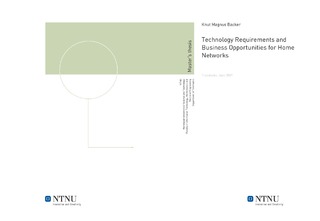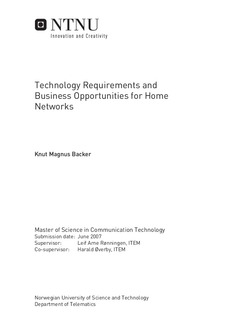| dc.description.abstract | Broadband connectivity has increased significantly the last years. More and more households choose to subscribe to services from various broadband companies. This has led to a range of new services. Some of these have high demands to both bandwidth and quality of service. Network operators have until recently neglected the challenges of providing network coverage within customer homes. Wireless solutions have been widely used, but new and demanding services like HDTV will either need a wired network or a significantly improved wireless standard. The complexity of in-home connectivity has increased dramatically because of a constant increasing number of devices and severe technical requirements. Convergence of earlier separated services is one of the main reasons for these new technical challenges. Different services with various demands are delivered over the same physical pipeline. The convergence of television, Internet and voice services, known as triple play, is delivered by both cable and fibre network operators today. Telecom operators are looking for ways to deliver triple play to compete in this new market. In addition to technical challenges, high costs and uncertain revenues slow down the development. In this thesis, we look at general technical requirements as well as business aspects regarding the development of a home network solution. Various technical solutions for in-home wiring are discussed. Because of high costs attended with installation of new wires in people's homes, usage of existing wiring is recommended. Power line technology (HomePlug) as well as data over coax and copper (HomePNA) are presented as actual solutions. Wireless LAN standards are mentioned and the new 802.11n standard is recommended as the next WLAN solution to be embedded in the future home network. The support of Ethernet is also recommended beacause it is well proven and delivers high bandwidth as well as low latency and jitter. The support for these various interfaces should be embedded in the Residential Gateway (RG) which is delivered by the network operator and resides in the transition between the access network and the home network. The RG is "the brain" in the home network and controls all services. One of the main tasks for the RG, is to deliver the appropriate Quality of Service (QoS) for the different services. This is done through a remote management system that ensures end-to-end QoS. The establishment of triple play leads to changes in existing business models. Telephone companies, broadcasters and cable network operators are among the involved actors. How to increase customers' value and how to ensure return on investment are central questions regarding the development of a triple play business model. Revenues must be ensured to get acceptance among stakeholders. A general business model for a network operator launching triple play is presented in the thesis. The model is based on a pre-defined business model ontology and uses elements from the involved actors' existing models. The establishment of the "connected home" which emphasize ease of use and personalization is central in the proposed value proposition. A home network user interface accessible from the various in-home devices is recommended to ensure customer control and user friendliness. Services like video on demand, personal video recording, interactive television and Internet should be accessible through the user interface. The network operator should differentiate from competitors by offering their customers a complete home network solution where ease of use, performance and personalization are emphasized. Partnerships with actors in the content and advertising industry as well as equipment manufacturers are discussed. To ensure low cost and high quality equipment as residential gateways and set top boxes, good partnerships with equipment manufacturers are essential. TV channels and independent content must be retrieved through partnerships with the copyright holders of the content. By making content available independent of TV-channels, network operators can take over parts of the television business which is operated by broadcasters and television programmers today. VoD and pay-per-view services will probably gradually take over for existing television services. Network operators have a golden opportunity to take over great shares of this business. Advertising can generate important revenues for network operators. The ability to personalize advertisements and offer shopping directly from the TV-set increases the value of advertising. Commercials can be displayed in the home network user interface and in connection with services as video on demand. Content with commercials attached can be offered at reduced price or for free, hence intercepting the customers with low willingness to pay. The financial aspects regarding home network solutions are discussed generally and with a low detailing level in this thesis. Huge costs are connected with the development of triple play and home network solutions, but there is also a high potential for revenue generating services and income from advertising and shopping. But, to generate any revenues, the network operator is dependent on customers. Hence, acquiring and retaining customers by delivering highly valued services and good customer support is the key to success. | nb_NO |

